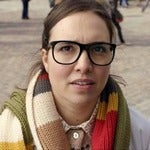Post by grahamthomson on Jun 12, 2009 6:50:42 GMT
Starscream (2007)
Transformers (2007)


Without undercarriage, an aircraft wouldn’t be able to land. In Starscream’s case, with so much undercarriage, he wouldn’t be able to take off. Based on the character’s design from the Transformers (2007) feature film, Starscream transforms from robot to officially licensed Lockheed Martin “F-22″ fighter jet. Or, more accurately, Starscream transforms into an F-22 mounted atop a pair of very bulky arms and a pair of legs.
Viewed from above, the jet mode is a close representation of the actual vehicle. From other angles, however, any illusion of disguise is utterly dashed. And yes, that is the robot’s head sticking out of the back of the jet, conspicuous for all to see.
Starscream’s colour scheme is primarily pearlescent beige with painted silver highlights and black sprayed gradients. Decepticon logos are screen printed in silver on top of the wings. The colours are nicely polished and, honestly, one of the few positive things to note about Starscream.
By rolling the jet forwards, the triple-barreled cannons under each wing rotate and fire their missiles in consecutive succession. I struggle to see the intelligence of such a feature in a jet, unless it’s helpful to blow up the runway ahead as it lands or spends its entire payload before taking off. The six missiles can alternatively be stored on flip-out mounting cradles.
Transforming Starscream from jet fighter to robot makes good use of the “Automorph” feature. Sliding the canopy back compresses the sides of the fuselage to form the upper body. The rest of the process is manual and reasonably straightforward.
Closely matching the character seen in the film, Starscream’s robot form resembles that of a massive bird of prey: with a hulking upper body and arms, coupled with backward knee joints and talons for feet. Even the head displays avian motifs (the character in the film has more of a beak on its forehead that its toy counterpart). The robot, while fully articulated, is surprisingly sturdy and solid with ratcheted joints used for the most part.
The same weapon-firing mechanism is utilised in robot mode as the under-wing cannons become the robot’s arms. This has an unfortunate side effect of rendering Starscream completely handless. There are fold out claws, but the way they’re designed makes them useless. The look of the robot is a far, far cry from the sleeker, slimmer shape of the original Starscream, and this design is either love-it or hate-it.
Heavily flawed, and not the most attractive of Transformers (even as Decepticons go), this version of Starscream is recommended only for those collecting all the characters from the Transformers (2007) film in toy form. Otherwise, leave in the hangar and take something else for a flight.
Verdict: two stars out of five.
Flickr Gallery: www.flickr.com/photos/the-hub/sets/72157616713800798/
Hublog: www.the-hub.co.uk/hublog/starscream-2007/
Transformers (2007)


Without undercarriage, an aircraft wouldn’t be able to land. In Starscream’s case, with so much undercarriage, he wouldn’t be able to take off. Based on the character’s design from the Transformers (2007) feature film, Starscream transforms from robot to officially licensed Lockheed Martin “F-22″ fighter jet. Or, more accurately, Starscream transforms into an F-22 mounted atop a pair of very bulky arms and a pair of legs.
Viewed from above, the jet mode is a close representation of the actual vehicle. From other angles, however, any illusion of disguise is utterly dashed. And yes, that is the robot’s head sticking out of the back of the jet, conspicuous for all to see.
Starscream’s colour scheme is primarily pearlescent beige with painted silver highlights and black sprayed gradients. Decepticon logos are screen printed in silver on top of the wings. The colours are nicely polished and, honestly, one of the few positive things to note about Starscream.
By rolling the jet forwards, the triple-barreled cannons under each wing rotate and fire their missiles in consecutive succession. I struggle to see the intelligence of such a feature in a jet, unless it’s helpful to blow up the runway ahead as it lands or spends its entire payload before taking off. The six missiles can alternatively be stored on flip-out mounting cradles.
Transforming Starscream from jet fighter to robot makes good use of the “Automorph” feature. Sliding the canopy back compresses the sides of the fuselage to form the upper body. The rest of the process is manual and reasonably straightforward.
Closely matching the character seen in the film, Starscream’s robot form resembles that of a massive bird of prey: with a hulking upper body and arms, coupled with backward knee joints and talons for feet. Even the head displays avian motifs (the character in the film has more of a beak on its forehead that its toy counterpart). The robot, while fully articulated, is surprisingly sturdy and solid with ratcheted joints used for the most part.
The same weapon-firing mechanism is utilised in robot mode as the under-wing cannons become the robot’s arms. This has an unfortunate side effect of rendering Starscream completely handless. There are fold out claws, but the way they’re designed makes them useless. The look of the robot is a far, far cry from the sleeker, slimmer shape of the original Starscream, and this design is either love-it or hate-it.
Heavily flawed, and not the most attractive of Transformers (even as Decepticons go), this version of Starscream is recommended only for those collecting all the characters from the Transformers (2007) film in toy form. Otherwise, leave in the hangar and take something else for a flight.
Verdict: two stars out of five.
Flickr Gallery: www.flickr.com/photos/the-hub/sets/72157616713800798/
Hublog: www.the-hub.co.uk/hublog/starscream-2007/


